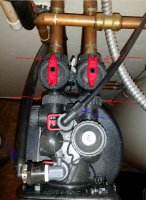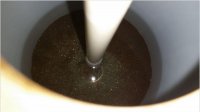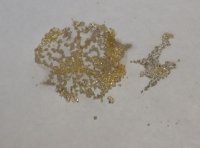azbenf
New Member
About 6 years ago I purchased a system from a local (and reputable) Phoenix area water quality company and has worked well until lateley. From reading here it seems the unit is way oversized for a two person household, but think it was sized more for the house (4000 sq ft) and potential occupants, and number of bathrooms (5), rather than how much we'd use in reality. It's just my wife and myself, and we're pretty low water users.
Recently it seems to be operating less efficiently and about 100 gallons before the demand-scheduled regen takes place the water from the faucets starts to feel quite hard. A couple years ago I increased the hardness setting on the control valve but it seems like I need to do that yet again. I do check for a salt bridge between refills (Morton System Saver II pellets). I've been careful never to overfill the brine tank not putting in more than 2 bags at a time, and salt level in tank is always half full or less.
The system itself is a 48,000 capacity with a Clack WS1 control valve, brine tank is separate from resin tank. I can post a link to the exact system if it's allowed but it's referred to as "The President" model and will come up as the first link in Google if searched on. Incoming water is treated city water. When first installed water hardness was 11 gpg, I just checked yesterday and its about 20 gpg now so it's increased, but still think my settings/unit should be able to handle it. No iron present in water. PH was 6.5 last time measured, chlorine = .8, alk = 80. I checked for hardness at the faucet today and it showed about 2 gpg even though regen was done a couple days ago, though admittedly the salt in the brine tank is low (I'm about the empty/clean it out and replace pellet salt with solar salt). The brine tank has never been cleaned but will be doing that this weekend. I don't know if it matters but water pressure was kicked up in our area about a year ago from 60 psi to 80 psi.
The Clack WS1 is currently set as follows: Hardness = 39; Day override = off; Capacity = 48,000; Pounds of salt per regen = 12; Backwash time = normal; Gallons before regen = auto; Refill = post regen; Regenerant flow = down; Regen time option = normal
I went through the diags and valve history and here's what I think could be useful stats: Max flow rate last 7 days = 7.2 gal per minute; Total days since last reset = 2172 (6 years); Total gallons since last reset = 129,000; Total regens since last reset = 112. Doing the math that averages to 59 gallons total per day, and a regen every 19 days.
So my system seems way oversized and am wondering what I can do to help it soften water as efficiently as possible. I don't care about salt usage, if that number has to be high I'm okay with that, but I'd prefer to keep the water wasted at a minimum as we're on a septic system. From reading it sounds like a regen should be done about every 10-14 days even if the gallon usage hasn't reached the regen trigger point so that's something I was going to change: Regen when gallons reaches 0 trigger point OR every 10 days. I'm also considering switching to brine pre-regen fill rather than post-regen fill though is more of a "warm fuzzy" for me. The water level in the brine tank after a post fill seems very high to me, about 1/3 full when almost out of salt and typically is always above the salt line, and sits for a long time between regens. Not sure if that's a good or bad thing.
Beyond that I'm not sure what, or if, I should change within the valve settings. As mentioned above I'm going to switch from pellet to solar salt. Should I make any changes to the unit settings like capacity (reduce to a lower number?), pounds of salt per regen (reduce from 12 since I'll be doing a regen more often), or increase/decrease the hardness setting from 39? Or has lack of use potentially fouled or made the media less efficient?
Ideas or suggestions would be appreciated. Apologies for the long post and/or if I missed anything important.
Recently it seems to be operating less efficiently and about 100 gallons before the demand-scheduled regen takes place the water from the faucets starts to feel quite hard. A couple years ago I increased the hardness setting on the control valve but it seems like I need to do that yet again. I do check for a salt bridge between refills (Morton System Saver II pellets). I've been careful never to overfill the brine tank not putting in more than 2 bags at a time, and salt level in tank is always half full or less.
The system itself is a 48,000 capacity with a Clack WS1 control valve, brine tank is separate from resin tank. I can post a link to the exact system if it's allowed but it's referred to as "The President" model and will come up as the first link in Google if searched on. Incoming water is treated city water. When first installed water hardness was 11 gpg, I just checked yesterday and its about 20 gpg now so it's increased, but still think my settings/unit should be able to handle it. No iron present in water. PH was 6.5 last time measured, chlorine = .8, alk = 80. I checked for hardness at the faucet today and it showed about 2 gpg even though regen was done a couple days ago, though admittedly the salt in the brine tank is low (I'm about the empty/clean it out and replace pellet salt with solar salt). The brine tank has never been cleaned but will be doing that this weekend. I don't know if it matters but water pressure was kicked up in our area about a year ago from 60 psi to 80 psi.
The Clack WS1 is currently set as follows: Hardness = 39; Day override = off; Capacity = 48,000; Pounds of salt per regen = 12; Backwash time = normal; Gallons before regen = auto; Refill = post regen; Regenerant flow = down; Regen time option = normal
I went through the diags and valve history and here's what I think could be useful stats: Max flow rate last 7 days = 7.2 gal per minute; Total days since last reset = 2172 (6 years); Total gallons since last reset = 129,000; Total regens since last reset = 112. Doing the math that averages to 59 gallons total per day, and a regen every 19 days.
So my system seems way oversized and am wondering what I can do to help it soften water as efficiently as possible. I don't care about salt usage, if that number has to be high I'm okay with that, but I'd prefer to keep the water wasted at a minimum as we're on a septic system. From reading it sounds like a regen should be done about every 10-14 days even if the gallon usage hasn't reached the regen trigger point so that's something I was going to change: Regen when gallons reaches 0 trigger point OR every 10 days. I'm also considering switching to brine pre-regen fill rather than post-regen fill though is more of a "warm fuzzy" for me. The water level in the brine tank after a post fill seems very high to me, about 1/3 full when almost out of salt and typically is always above the salt line, and sits for a long time between regens. Not sure if that's a good or bad thing.
Beyond that I'm not sure what, or if, I should change within the valve settings. As mentioned above I'm going to switch from pellet to solar salt. Should I make any changes to the unit settings like capacity (reduce to a lower number?), pounds of salt per regen (reduce from 12 since I'll be doing a regen more often), or increase/decrease the hardness setting from 39? Or has lack of use potentially fouled or made the media less efficient?
Ideas or suggestions would be appreciated. Apologies for the long post and/or if I missed anything important.



